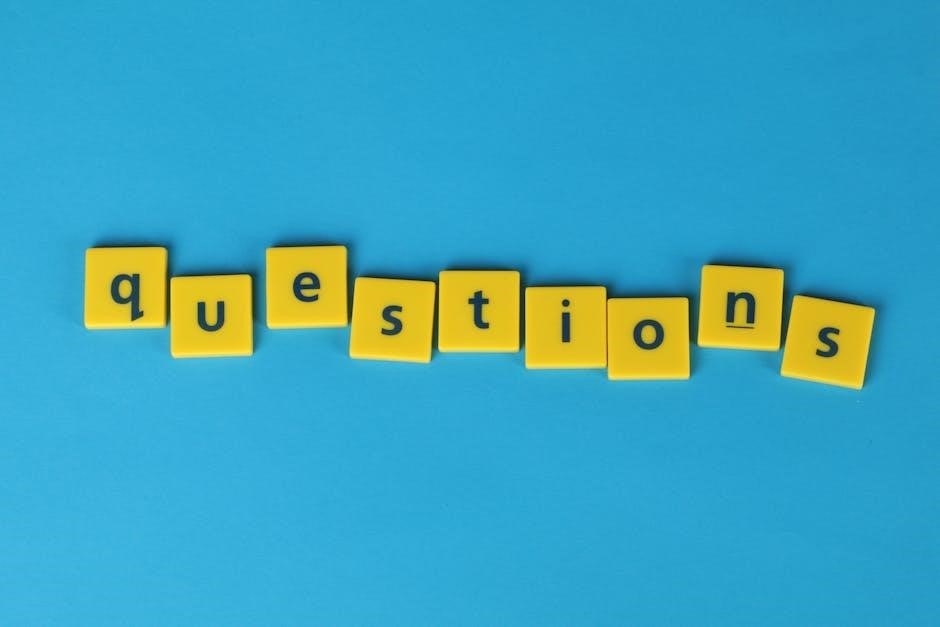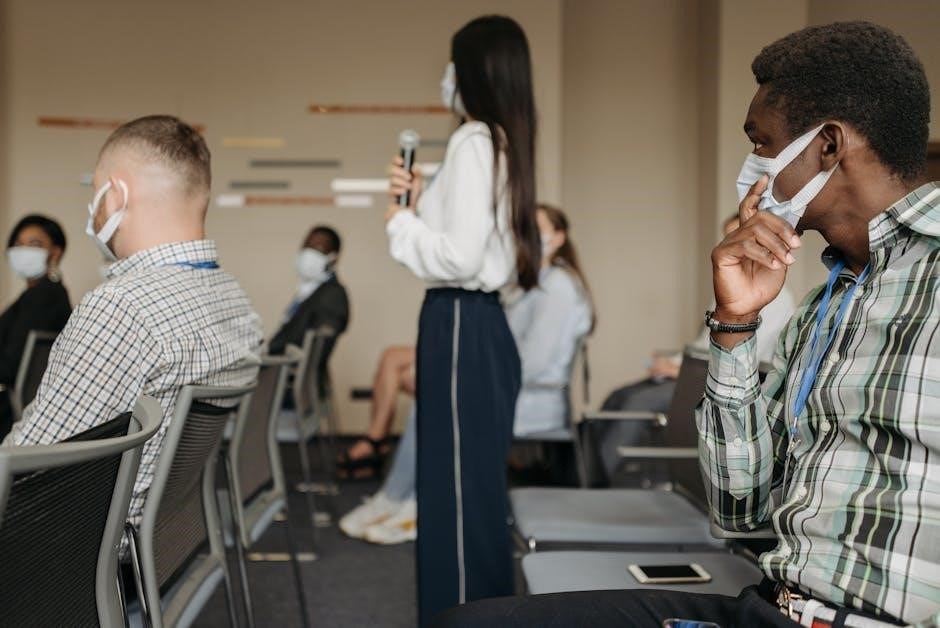Guided questions are structured inquiries designed to direct thinking, explore topics, and gather information effectively, fostering critical thinking and meaningful dialogue in various contexts.
Definition and Purpose of Guided Questions
Guided questions are carefully crafted inquiries designed to focus exploration, provoke thought, and extract specific information. Their purpose is to direct discussions, clarify ideas, and ensure targeted responses, making them invaluable in education, research, and problem-solving. By guiding the flow of inquiry, these questions help uncover deeper insights and foster meaningful conversations, ensuring clarity and precision in understanding complex topics or addressing specific needs.
Importance in Critical Thinking and Problem-Solving
Guided questions play a pivotal role in fostering critical thinking by stimulating analysis, clarifying assumptions, and encouraging deeper exploration of ideas. They help individuals identify patterns, evaluate information, and develop well-reasoned conclusions. In problem-solving, these questions enable systematic exploration of challenges, promoting creative and effective solutions. By guiding thought processes, they enhance understanding, improve decision-making, and empower individuals to navigate complex situations with confidence and precision.

Types of Guided Questions
Guided questions are categorized into open-ended and closed-ended types, each serving distinct purposes. Open-ended questions encourage detailed responses, while closed-ended questions seek specific, concise answers, ensuring clarity and focus.
4.1 Open-Ended Questions
Open-ended questions are inquiries that cannot be answered with a simple “yes” or “no.” They encourage detailed responses, fostering creativity, critical thinking, and deeper exploration of topics. These questions are essential in educational and therapeutic settings, as they allow individuals to articulate their thoughts and feelings fully. For example, “What do you think about…” or “Can you explain…” prompts provide insights into a person’s understanding or emotions, making them invaluable for meaningful discussions and learning outcomes.
4.2 Closed-Ended Questions
Closed-ended questions are structured to elicit specific, concise responses, often requiring a “yes” or “no” answer or selecting from predefined options. These questions guide respondents toward precise information, making them ideal for surveys, assessments, and data collection. Examples include “Did you attend the event?” or “On a scale of 1 to 5, how satisfied were you?” They provide clear, quantifiable data, simplifying analysis and comparison of responses across groups or individuals.
Examples of Guided Questions in Various Settings
Guided questions are applied across education, healthcare, and business to clarify thoughts, assess understanding, or guide decision-making, providing structure for productive discussions and problem-solving scenarios.
5.1 Educational Context
In education, guided questions are used to encourage critical thinking, promote deeper understanding, and assess student knowledge. Teachers employ them to stimulate discussions, explore complex concepts, and help students connect new information to prior learning. These questions often guide learners through problem-solving processes, fostering active engagement and higher-order thinking skills. By framing inquiries clearly, educators can identify knowledge gaps and tailor instruction to meet student needs, ensuring alignment with curriculum goals.
5.2 Therapeutic Context
In therapy, guided questions are tools used to help clients explore their thoughts, emotions, and behaviors. They encourage self-reflection, clarify concerns, and guide individuals toward insights or solutions. Therapists use these questions to create a safe space for expression, identify patterns, and support personal growth. By framing inquiries thoughtfully, professionals can address specific issues, foster emotional awareness, and empower clients to make meaningful changes, aligning with therapeutic goals and promoting healing.
5.3 Market Research Context
In market research, guided questions are essential for gathering specific, actionable data. They help uncover consumer preferences, behaviors, and opinions, enabling businesses to make informed decisions. These questions are often used in surveys, interviews, or focus groups to explore trends, identify needs, and assess competitor landscapes. By structuring inquiries to target specific areas, researchers ensure clarity and relevance, ultimately driving strategic planning and innovation in the marketplace.
Benefits of Using Guided Questions
Guided questions enhance focus, organize thoughts, and improve understanding by providing clear direction and encouraging engagement in various contexts. They foster critical thinking and effective communication.
6.1 Encouraging Deeper Thinking
Guided questions promote critical thinking by prompting individuals to analyze information, explore perspectives, and form meaningful connections. They encourage users to move beyond surface-level understanding, fostering reflection and insightful problem-solving. This structured approach helps individuals organize their thoughts and engage more deeply with the subject matter, leading to a more comprehensive understanding and application of knowledge in various contexts.
6.2 Improving Communication
Guided questions enhance communication by encouraging clarity, active listening, and thoughtful expression. They help individuals articulate their ideas more effectively, ensuring understanding and alignment. By focusing discussions and preventing miscommunication, guided questions foster a collaborative environment where participants feel heard and valued. This structured approach promotes concise and purposeful dialogue, making interactions more productive and meaningful in both personal and professional settings.
6.3 Enhancing Learning Outcomes
Guided questions are a powerful tool for improving educational experiences by engaging learners and fostering deeper understanding. They encourage active participation, critical thinking, and reflection, making complex concepts more accessible. By structuring discussions and reinforcing key ideas, guided questions help students connect new information to prior knowledge, enhancing retention and application of skills. This approach ensures learning is meaningful, interactive, and aligned with educational goals.

Challenges in Implementing Guided Questions
Challenges include designing clear, relevant questions and managing diverse, potentially unstructured responses. Ensuring questions align with goals and interpreting varied answers require skill and careful planning.
7;1 Designing Effective Questions
Designing effective guided questions requires clarity, specificity, and alignment with objectives. Questions must be concise, avoiding ambiguity, and tailored to the audience. Techniques like using clear language, avoiding jargon, and ensuring relevance are crucial. Open-ended questions encourage deeper thinking, while closed-ended questions gather specific data. Balancing these types ensures diverse insights. Challenges include avoiding leading questions and ensuring engagement. Effective design fosters critical thinking and problem-solving, making it a cornerstone of successful guided questioning strategies.
7.2 Managing Diverse Responses
Managing diverse responses involves actively listening, categorizing, and synthesizing feedback to ensure clarity and inclusivity. Tools like note-taking and structured facilitation techniques help organize varied input. Paraphrasing and summarizing responses can enhance understanding. Challenges arise in balancing differing opinions and maintaining focus. Effective management fosters collaboration, ensuring all voices are heard and valued. This approach promotes constructive dialogue and meaningful engagement, essential for successful guided questioning outcomes.
Best Practices for Designing Guided Questions
Effective guided questions require clarity, specificity, and cultural sensitivity. Ensure questions are concise, unbiased, and relevant to the context to maximize engagement and meaningful responses.
8.1 Clarity and Specificity
Clarity and specificity are essential for effective guided questions. Avoid vague language and ensure questions are well-defined to target the desired information. Use precise terms and avoid ambiguity. For example, instead of asking, “What do you think?” ask, “What specific steps could improve this process?” This approach ensures responses are focused and relevant, enhancing the quality of dialogue and understanding. Clear questions guide respondents effectively.
8.2 Cultural Sensitivity
Cultural sensitivity is crucial when designing guided questions. Be mindful of diverse backgrounds and avoid assumptions or biases. Use inclusive language and ensure questions are appropriate across cultures. For instance, avoid idioms or references specific to one culture. This fosters respect and ensures all participants feel comfortable contributing, promoting equitable and meaningful engagement regardless of cultural differences. Sensitivity enhances the effectiveness of guided questions in diverse settings.
Applications in Different Fields
Guided questions are applied in education, therapy, and market research to enhance learning, aid therapeutic processes, and gather actionable insights, making them versatile tools across disciplines.
9.1 Education
In education, guided questions are essential for fostering critical thinking and active participation. Teachers design these inquiries to encourage deeper analysis, promote engagement, and help students explore concepts thoroughly. By framing questions that prompt reflection and inquiry, educators guide learners toward understanding complex ideas and developing problem-solving skills; This approach enhances classroom discussions and supports personalized learning experiences, making it a cornerstone of effective pedagogy.
9.2 Market Research
In market research, guided questions are used to gather precise and actionable data about consumer preferences, behaviors, and opinions. These questions help researchers understand target audiences, identify trends, and refine products or services. By structuring inquiries to explore specific aspects of customer experiences, businesses can make informed decisions. Techniques like surveys, interviews, and focus groups rely on guided questions to ensure relevant and meaningful insights, driving strategic improvements and innovation.
9.3 Therapy
Guided questions in therapy are tools used to help patients explore their thoughts, emotions, and experiences. Therapists use these questions to encourage self-reflection, identify patterns, and promote insight. By framing inquiries in a non-leading and empathetic way, therapists can help clients process challenges, set goals, and develop coping strategies. This approach fosters a collaborative environment, enabling individuals to gain clarity and work toward personal growth and emotional well-being.

Tools and Techniques for Effective Use
Guided questions are enhanced using technology tools like survey software and interactive platforms, along with facilitation techniques such as active listening and follow-up prompts for clarity.
10.1 Technology Tools
Technology tools like Google Forms, Qualtrics, and Mentimeter enable the creation and distribution of guided questions, facilitating data collection and analysis. AI-powered chatbots can generate and organize questions, while platforms like Kahoot! and PollEverywhere support interactive sessions. These tools enhance engagement, streamline feedback collection, and provide real-time insights, making guided questions more accessible and effective in various settings. They also integrate with other systems for seamless data management and reporting.
10;2 Facilitation Techniques
Effective facilitation techniques enhance the use of guided questions by encouraging active participation and focused discussions. Active listening ensures comprehensive understanding, while prompting and probing helps clarify responses. Managing diverse perspectives keeps conversations productive. These methods foster engagement and ensure that guided questions achieve their intended goals in various settings, making interactions more meaningful and effective.
Measuring the Effectiveness of Guided Questions
Evaluate the impact of guided questions using assessment metrics and feedback mechanisms to ensure clarity, relevance, and engagement, aligning outcomes with intended goals and improving future interactions.
11.1 Assessment Metrics
Assessment metrics for guided questions involve evaluating response quality, engagement levels, and alignment with objectives. Common metrics include response rates, clarity of answers, and depth of critical thinking demonstrated. Tools like surveys, feedback forms, and automated analytics can measure effectiveness. These metrics help identify whether questions prompt meaningful reflection and achieve desired outcomes, providing insights for improvement and ensuring questions remain relevant and impactful in various contexts.
11.2 Feedback Mechanisms
Feedback mechanisms involve collecting and analyzing responses to refine guided questions. Tools like surveys, focus groups, and digital platforms gather participant insights, ensuring questions are clear and effective. Continuous feedback helps identify areas for improvement, enhancing engagement and understanding. These mechanisms also allow for real-time adjustments, making guided questions more impactful and aligned with user needs in educational, therapeutic, and research contexts.

Common Mistakes to Avoid
Common mistakes to avoid when using guided questions include overly complex queries and leading questions, which can confuse respondents and skew results, reducing effectiveness.
12.1 Overly Complex Questions
Overly complex questions often confuse respondents, leading to misinterpretation or incomplete answers. They may include jargon, multiple parts, or ambiguous phrasing, reducing clarity and effectiveness. Simplifying language and focusing on specific, clear objectives ensure better understanding and more accurate responses. Avoid using technical terms or convoluted structures that might alienate or overwhelm participants. Clear, concise questions yield more reliable and actionable data.
12.2 Leading Questions
Leading questions subtly suggest a particular answer, influencing respondents’ replies and introducing bias. They often contain loaded language or assumptions, making them problematic in surveys or interviews. For example, “Don’t you think this policy is effective?” assumes a positive view. Such questions can skew results and undermine data integrity. To avoid bias, focus on neutral phrasing that allows respondents to answer freely without suggestion or implication.
Future Trends in Guided Questions
Future trends include integration with AI, real-time data analysis, and dynamic questioning, enhancing precision and personalization in gathering insights and facilitating informed decision-making processes effectively.
13.1 Integration with AI
Guided questions will increasingly integrate with AI, enabling dynamic generation of inquiries based on real-time data and user responses. AI-driven tools will analyze patterns, predict needs, and adapt questions to enhance engagement and accuracy. This synergy will revolutionize fields like education, research, and therapy, offering personalized and intelligent questioning experiences that foster deeper insights and more effective problem-solving, making the process more intuitive and responsive to individual needs.
13.2 Use of Real-Time Data
Guided questions will leverage real-time data to enhance relevance and accuracy, enabling immediate feedback and dynamic adjustments. This integration allows for timely insights, such as current trends or user behaviors, making inquiries more responsive and impactful. Real-time data ensures questions are up-to-date, addressing evolving needs and providing actionable results, whether in market research, education, or therapy, thereby improving decision-making and engagement across various applications.

Leave a Reply